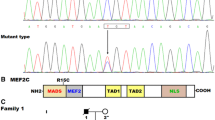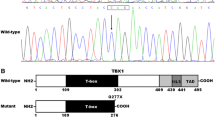Abstract
The ventriculoseptal defect (VSD) is the most common form of congenital heart disease and a leading noninfectious cause of infant mortality. Growing evidence demonstrates that genetic defects are associated with congenital VSD. Nevertheless, VSD is genetically heterogeneous, and the molecular basis for VSD in an overwhelming majority of patients remains unknown. In this study, the whole coding region of GATA5, a gene encoding a zinc finger transcription factor crucial for normal cardiogenesis, was sequenced in 120 unrelated patients with VSD. The available relatives of the patient harboring the identified mutation and 200 unrelated individuals used as controls were subsequently genotyped. The causative potential of a sequence variation was evaluated by MutationTaster, and the functional effect of the mutation was characterized using a luciferase reporter assay system. As a result, a novel heterozygous GATA5 mutation, p.L199V, was identified in a patient with VSD, which was absent in 400 control chromosomes. Genetic analysis of the mutation carrier’s available family members showed that the substitution co-segregated with VSD transmitted in an autosomal dominant pattern. The p.L199V variation was automatically predicted to be disease causing, and the functional analysis showed that the GATA5 p.L199V mutant protein was associated with significantly reduced transcriptional activation compared with its wild-type counterpart. To the best of the authors’ knowledge, this is the first report on the link of functionally compromised GATA5 to human VSD, suggesting potential implications for the early prophylaxis and personalized treatment of VSD.





Similar content being viewed by others
References
Bartlett H, Veenstra GJ, Weeks DL (2010) Examining the cardiac NK-2 genes in early heart development. Pediatr Cardiol 31:335–341
Benson DW (2010) Genetic origins of pediatric heart disease. Pediatr Cardiol 31:422–429
Bruneau BG (2008) The developmental genetics of congenital heart disease. Nature 451:943–948
Butler TL, Esposito G, Blue GM, Cole AD, Costa MW, Waddell LB, Walizada G, Sholler GF, Kirk EP, Feneley M, Harvey RP, Winlaw DS (2010) GATA4 mutations in 357 unrelated patients with congenital heart malformation. Genet Test Mol Biomark 14:797–802
Cecchetto A, Rampazzo A, Angelini A, Bianco LD, Padalino M, Stellin G, Daliento L (2010) From molecular mechanisms of cardiac development to genetic substrate of congenital heart diseases. Future Cardiol 6:373–393
Chen MW, Pang YS, Guo Y, Pan JH, Liu BL, Shen J, Liu TW (2010) GATA4 mutations in Chinese patients with congenital cardiac septal defects. Pediatr Cardiol 31:85–89
Chen Y, Mao J, Sun Y, Zhang Q, Cheng HB, Yan WH, Choy KW, Li H (2010) A novel mutation of GATA4 in a familial atrial septal defect. Clin Chim Acta 411:1741–1745
Cheng HH, Almodovar MC, Laussen PC, Wypij D, Polito A, Brown DW, Emani SM, Pigula FA, Allan CK, Costello JM (2011) Outcomes and risk factors for mortality in premature neonates with critical congenital heart disease. Pediatr Cardiol 32:1139–1146
Garg V, Kathiriya IS, Barnes R, Schluterman MK, King IN, Butler CA, Rothrock CR, Eapen RS, Hirayama-Yamada K, Joo K, Matsuoka R, Cohen JC, Srivastava D (2003) GATA4 mutations cause human congenital heart defects and reveal an interaction with TBX5. Nature 424:443–447
Hamanoue H, Rahayuningsih SE, Hirahara Y, Itoh J, Yokoyama U, Mizuguchi T, Saitsu H, Miyake N, Hirahara F, Matsumoto N (2009) Genetic screening of 104 patients with congenitally malformed hearts revealed a fresh mutation of GATA4 in those with atrial septal defects. Cardiol Young 19:482–485
Hartman RJ, Rasmussen SA, Botto LD, Riehle-Colarusso T, Martin CL, Cragan JD, Shin M, Correa A (2011) The contribution of chromosomal abnormalities to congenital heart defects: a population-based study. Pediatr Cardiol 32:1147–1157
Heicklen-Klein A, McReynolds LJ, Evans T (2005) Using the zebra fish model to study GATA transcription factors. Semin Cell Dev Biol 16:95–106
Henderson DJ, Anderson RH (2009) The development and structure of the ventricles in the human heart. Pediatr Cardiol 30:588–596
Hirayama-Yamada K, Kamisago M, Akimoto K, Aotsuka H, Nakamura Y, Tomita H, Furutani M, Imamura S, Takao A, Nakazawa M, Matsuoka R (2005) Phenotypes with GATA4 or NKX2.5 mutations in familial atrial septal defect. Am J Med Genet A 135:47–52
Kasahara H, Lee B, Schott JJ, Benson DW, Seidman JG, Seidman CE, Izumo S (2000) Loss of function and inhibitory effects of human CSX/NKX2.5 homeoprotein mutations associated with congenital heart disease. J Clin Investig 106:299–308
Kodo K, Nishizawa T, Furutani M, Arai S, Yamamura E, Joo K, Takahashi T, Matsuoka R, Yamagishi H (2009) GATA6 mutations cause human cardiac outflow tract defects by disrupting semaphorin-plexin signaling. Proc Natl Acad Sci USA 106:13933–13938
Laforest B, Nemer M (2011) GATA5 interacts with GATA4 and GATA6 in outflow tract development. Dev Biol 358:368–378
Lin X, Huo Z, Liu X, Zhang Y, Li L, Zhao H, Yan B, Liu Y, Yang Y, Chen YH (2010) A novel GATA6 mutation in patients with tetralogy of Fallot or atrial septal defect. J Hum Genet 55:662–667
Liu XY, Wang J, Zheng JH, Bai K, Liu ZM, Wang XZ, Liu X, Fang WY, Yang YQ (2011) Involvement of a novel GATA4 mutation in atrial septal defects. Int J Mol Med 28:17–23
Maitra M, Koenig SN, Srivastava D, Garg V (2010) Identification of GATA6 sequence variants in patients with congenital heart defects. Pediatr Res 68:281–285
McQuillen PS, Miller SP (2010) Congenital heart disease and brain development. Ann NY Acad Sci 1184:68–86
Mead PE, Brivanlou IH, Kelley CM, Zon LI (1996) BMP-4-responsive regulation of dorsal–ventral patterning by the homeobox protein Mix.1. Nature 382:357–360
Minette MS, Sahn DJ (2006) Ventricular septal defects. Circulation 114:2190–2197
Nemer G, Qureshi ST, Malo D, Nemer M (1999) Functional analysis and chromosomal mapping of Gata5, a gene encoding a zinc finger DNA-binding protein. Mamm Genome 10:993–999
Nemer G, Fadlalah F, Usta J, Nemer M, Dbaibo G, Obeid M, Bitar F (2006) A novel mutation in the GATA4 gene in patients with tetralogy of Fallot. Hum Mutat 27:293–294
Okubo A, Miyoshi O, Baba K, Takagi M, Tsukamoto K, Kinoshita A, Yoshiura K, Kishino T, Ohta T, Niikawa N, Matsumoto N (2004) A novel GATA4 mutation completely segregated with atrial septal defect in a large Japanese family. J Med Genet 41:e97
Payne AR, Chang SW, Koenig SN, Zinn AR, Garg V (2012) Submicroscopic chromosomal copy number variations identified in children with hypoplastic left heart syndrome. Pediatr Cardiol 33:757–763
Perry JC (2012) Sudden cardiac death and malignant arrhythmias: the scope of the problem in adult congenital heart patients. Pediatr Cardiol 33:484–490
Peterkin T, Gibson A, Loose M, Patient R (2005) The roles of GATA-4, -5, and -6 in vertebrate heart development. Semin Cell Dev Biol 16:83–94
Piggott KD, Sorbello A, Riddle E, DeCampli W (2011) Congenital cardiac defects: a possible association of aminopterin syndrome and in utero methotrexate exposure? Pediatr Cardiol 32:518–520
Pikkarainen S, Tokola H, Kerkelä R, Ruskoaho H (2004) GATA transcription factors in the developing and adult heart. Cardiovasc Res 63:196–207
Rajagopal SK, Ma Q, Obler D, Shen J, Manichaikul A, Tomita-Mitchell A, Boardman K, Briggs C, Garg V, Srivastava D, Goldmuntz E, Broman KW, Benson DW, Smoot LB, Pu WT (2007) Spectrum of heart disease associated with murine and human GATA4 mutation. J Mol Cell Cardiol 43:677–685
Reamon-Buettner SM, Borlak J (2005) GATA4 zinc finger mutations as a molecular rationale for septation defects of the human heart. J Med Genet 42:e32
Roger VL, Go AS, Lloyd-Jones DM, Benjamin EJ, Berry JD, Borden WB, Bravata DM, Dai S, Ford ES, Fox CS, Fullerton HJ, Gillespie C, Hailpern SM, Heit JA, Howard VJ, Kissela BM, Kittner SJ, Lackland DT, Lichtman JH, Lisabeth LD, Makuc DM, Marcus GM, Marelli A, Matchar DB, Moy CS, Mozaffarian D, Mussolino ME, Nichol G, Paynter NP, Soliman EZ, Sorlie PD, Sotoodehnia N, Turan TN, Virani SS, Wong ND, Woo D, Turner MB, American Heart Association Statistics Committee and Stroke Statistics Subcommittee (2012) Heart disease and stroke statistics—2012 update: a report from the American Heart Association. Circulation 125:e2–e220
Salazar M, Consoli F, Villegas V, Caicedo V, Maddaloni V, Daniele P, Caianiello G, Pachón S, Nuñez F, Limongelli G, Pacileo G, Marino B, Bernal JE, De Luca A, Dallapiccola B (2011) Search of somatic GATA4 and NKX2.5 gene mutations in sporadic septal heart defects. Eur J Med Genet 54:306–309
Sarkozy A, Conti E, Neri C, D’Agostino R, Digilio MC, Esposito G, Toscano A, Marino B, Pizzuti A, Dallapiccola B (2005) Spectrum of atrial septal defects associated with mutations of NKX2.5 and GATA4 transcription factors. J Med Genet 42:e16
Shedeed SA, Elfaytouri E (2011) Brain maturity and brain injury in newborns with cyanotic congenital heart disease. Pediatr Cardiol 32:47–54
Silka MJ, Bar-Cohen Y (2012) A contemporary assessment of the risk for sudden cardiac death in patients with congenital heart disease. Pediatr Cardiol 33:452–460
Sommer RJ, Hijazi ZM, Rhodes JF Jr (2008) Pathophysiology of congenital heart disease in the adult: Part I. Shunt lesions. Circulation 117:1090–1099
Teixeira FM, Coelho RM, Proença C, Silva AM, Vieira D, Vaz C, Moura C, Viana V, Areias JC, Areias ME (2011) Quality of life experienced by adolescents and young adults with congenital heart disease. Pediatr Cardiol 32:1132–1138
Tomita-Mitchell A, Maslen CL, Morris CD, Garg V, Goldmuntz E (2007) GATA4 sequence variants in patients with congenital heart disease. J Med Genet 44:779–783
Wang J, Fang M, Liu XY, Xin YF, Liu ZM, Chen XZ, Wang XZ, Fang WY, Liu X, Yang YQ (2011) A novel GATA4 mutation responsible for congenital ventricular septal defects. Int J Mol Med 28:557–564
Yang YQ, Li L, Wang J, Liu XY, Chen XZ, Zhang W, Wang XZ, Jiang JQ, Liu X, Fang WY (2012) A novel GATA4 loss-of-function mutation associated with congenital ventricular septal defect. Pediatr Cardiol 33:539–546
Yang YQ, Wang J, Liu XY, Chen XZ, Zhang W, Wang XZ, Liu X, Fang WY (2012) Novel GATA4 mutations in patients with congenital ventricular septal defects. Med Sci Monit 18:CR344–CR350
Yang YQ, Wang J, Wang XH, Wang Q, Tan HW, Zhang M, Shen FF, Jiang JQ, Fang WY, Liu X (2012) Mutational spectrum of the GATA5 gene associated with familial atrial fibrillation. Int J Cardiol 157:305–307
Zhang W, Li X, Shen A, Jiao W, Guan X, Li Z (2008) GATA4 mutations in 486 Chinese patients with congenital heart disease. Eur J Med Genet 51:527–535
Zheng GF, Wei D, Zhao H, Zhou N, Yang YQ, Liu XY (2012) A novel GATA6 mutation associated with congenital ventricular septal defect. Int J Mol Med 29:1065–1071
Acknowledgments
We are indebted to the participants for their dedication to the study. This work was supported in part by grants from the National Natural Science Fund of China (81070153 and 3050768), the Natural Science Fund of Shanghai, China (10ZR1428000 and 10ZR1433100), the Key Program of Basic Research of Shanghai (10JC1414000, 10JC1414001, and 10JC1414002), and the National Basic Research Program of China (2010CB912604).
Author information
Authors and Affiliations
Corresponding authors
Additional information
D. Wei and H. Bao contributed equally to this work.
Rights and permissions
About this article
Cite this article
Wei, D., Bao, H., Zhou, N. et al. GATA5 Loss-of-Function Mutation Responsible for the Congenital Ventriculoseptal Defect. Pediatr Cardiol 34, 504–511 (2013). https://doi.org/10.1007/s00246-012-0482-6
Received:
Accepted:
Published:
Issue Date:
DOI: https://doi.org/10.1007/s00246-012-0482-6




